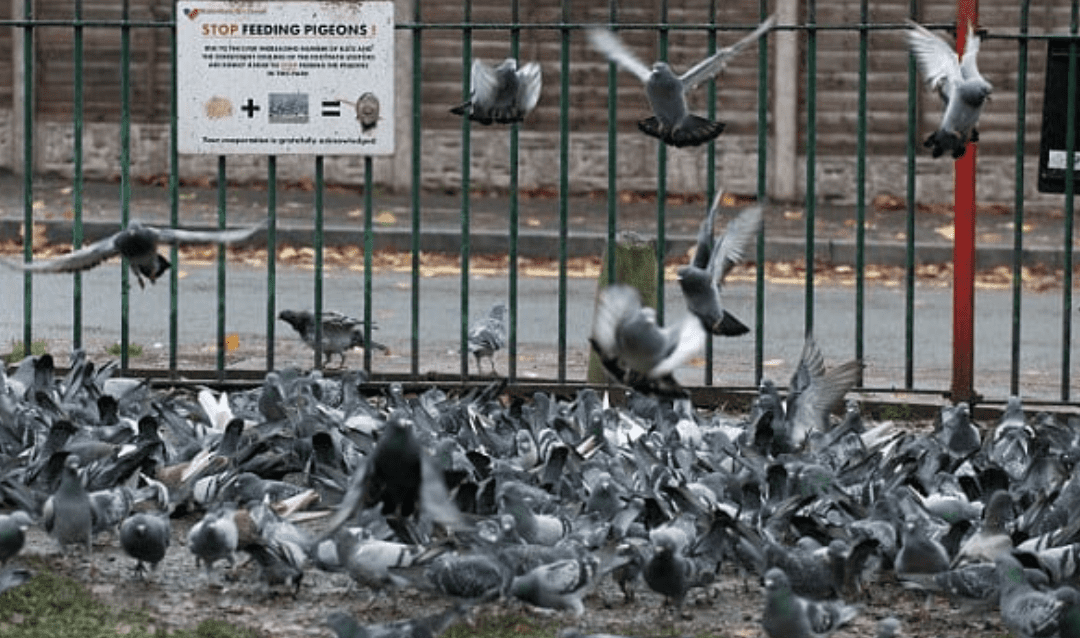
by Pigeon Patrol | Mar 29, 2022 | MBCA, pet bird, Pigeon Control, Pigeon Droppings, Pigeon Patrol's Services, Pigeon Predators
Why Control Birds?
- They can lead to large-scale pig feed losses
- They can spread human and animal disease and carry parasites, and
- They can damage property.
Feed Wastage
- Feed wastage through birds can be high, particularly on outdoor pig units.
- Birds can take large volumes of sow rolls, equating to high financial losses and make it difficult to estimate quantities being eaten by the sows themselves.
- On average, bird feed intake can be 24g per bird per day, rising to 50g per bird in a single feed when herring gulls are the main species; this feed loss can cost thousands of pounds over the course of a year, and
- Feed losses can impact on sow productivity and piglet viability.
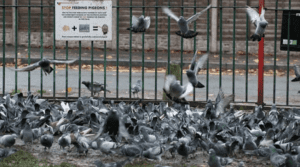
Disease
- Disease organisms spread by birds include: Brachyspira hyodysenteriae (swine dysentery) Salmonella spp., Escherichia coli, Campylobacter spp. and Listeria monocytogenes.
- Pigs are at risk of becoming infected with these organisms through poor standards of hygiene, after being in contact with droppings or if birds contaminate their food or water.
- High levels of birds on units can introduce new strains of Salmonella and re-circulate existing infections; this can result in more pigs carrying Salmonella at slaughter
- People can also be at risk of Salmonella and other infections through similar transmission methods.
Birds Most Likely to be Seen on Pig Units
- Gulls
- Crows
- Pigeons – particularly hard to eliminate
- Starlings – a particular problem during the winter
- Birds of prey – birds of prey will take young piglets and feed off dead piglets and afterbirth.
Bird Prevention
- Manage and prevent access to feed, especially feed wastage around mills, bins and feeders; if food is available, birds will always return.
- Prevent bird population build-up through practical on-farm deterrent measures such as screens; galvanised mesh screens can have a payback on saved feed losses of around 4.5 years (based on an 800-place finisher building).
- An armoury of acoustic and visual scarers will be needed to control birds as they can become habituated to ‘scaring’ mechanisms quickly, often returning to units after a few days.
- Altering the scaring mechanism every few days is the best form of prevention.
- Some birds will be more affected by certain scaring mechanisms than others so it may be necessary to use two per day and mix them up.
Options for Minimising Bird Populations
- Good feed management
- reduce waste and spills
- minimise fines from cobs
- use cobs if starlings are the main problem
- use pellets if gulls are the main problem
- Cost-effective feeding strategies
- Feed by the fenceline
- Reduce the length of the feed face
- Use ad lib feeders with covers and chains around
- Replace material/flexible feeder covers for metal ones
- Trough feeding
- Wet feeding
- Exclude birds from buildings using netting/mesh screens (keep well maintained)
- Apply plastic strips to arc fronts to exclude small birds from gaining access
- Nails on posts.
Options for Scaring Birds
- Acoustic scarers, e.g. gas bangers and distress call audio tapes; note these are effective in the short term but birds will reappear
- Material kites (tied to a weight)
- Decoy birds
- Hawk falconry flights
- Decoy birds
- Walking with an empty gun or stick of similar length behind the tractor at feeding.
By reducing the availability of feed to birds, a number of long-term benefits will be seen, including reduced direct livestock feed losses and therefore improved productivity and viability, less chance of disease transmission and a reduced need for conventional short-term bird control methods.
Targeting and designing cost-effective feeding strategies are therefore key in controlling birds, as well as a greater use of mechanical controls such as lids on feeders and barriers at feed stores. The main requirement for mechanical controls is effective maintenance of the screens used.
Controlling Birds
- Under the Wildlife and Countryside Act 1981, it is possible to control certain species of bird in the UK.
- Persons relying on this licence must be satisfied that non-lethal methods (see examples above) of resolving the problem are ineffective or impracticable.
- Keep records including dates of non-lethal methods applied, to assist licence applications.
- There are special licences for different risks.
- The licence (general) most likely to be required by pig producers is ‘To kill or take certain wild birds to prevent serious damage or disease’. This licence is granted to:
- Prevent serious damage to livestock, foodstuffs for livestock, crops, vegetables, fruit, growing timber, fisheries or inland waters.
- Prevent the spread of disease.
Source
Pigeon Patrol Products & Services is the leading manufacturer and distributor of bird deterrent (control) products in Canada. Pigeon Patrol products have solved pest bird problems in industrial, commercial, and residential settings since 2000, by using safe and humane bird deterrents with only bird and animal friendly solutions. At Pigeon Patrol, we manufacture and offer a variety of bird deterrents, ranging from Ultra-flex Bird Spikes with UV protection, Bird Netting, 4-S Bird Gel and the best Ultrasonic and audible sound devices on the market today.
Voted Best Canadian wholesaler for Bird Deterrent products ten years in a row.
Contact us at 1- 877– 4– NO-BIRD, (604) 585-9279 or visit our website at www.pigeonpatrol.ca
Pigeon/Pigeon Patrol / Pigeons Roosting / Vancouver Pigeon Control /Bird Spikes / Bird Control / Bird Deterrent / Pigeon Deterrent? Surrey Pigeon Control / Pest /Seagull deterrent / Vancouver Pigeon Blog / Birds Inside Home / Pigeons in the cities / Ice Pigeons/ What to do about pigeons/ sparrows , Damage by Sparrows, How To Keep Raccoons Away, Why Are Raccoons Considered Pests/ De-fence / Pigeon Nesting/ Bird Droppings / Pigeon Dropping/ woodpecker control/ Professional Bird Control Company/ Keep The Birds Away/ Birds/rats/ seagull/pigeon/woodpecker/ dove/sparrow/pidgeon control/pidgeon problem/ pidgeon control/flying rats/ pigeon Problems/ bird netting/bird gel/bird spray/bird nails/ bird guard

by Pigeon Patrol | Mar 21, 2022 | Bird Spike, Pigeon Predators, Pigeon Spikes, Pigeons, Pigeons in the News, Raccoons, Sparrows, UltraSonic Bird Control
Watch out, pigeons… there’s a new cop in town! The Nevada Pigeon Control is a local business that pledges to contain the pigeon problem. They’ve got uniforms, cages, and air guns… all aimed at cutting down on the number of winged beasts. They say the county isn’t taking care of the bird problem. But Clark County says it will use pigeon birth control pills. Why are pigeons such a problem in Southern Nevada? Why are casinos hiring uniformed men with air guns? And why are so many groups all aflutter over the best way to handle this controversy? We talk to a “pigeon cop” and others tackling bird control. Fly into the conversation below.

Source
Pigeon Patrol Products & Services is the leading manufacturer and distributor of bird deterrent (control) products in Canada. Pigeon Patrol products have solved pest bird problems in industrial, commercial, and residential settings since 2000, by using safe and humane bird deterrents with only bird and animal friendly solutions. At Pigeon Patrol, we manufacture and offer a variety of bird deterrents, ranging from Ultra-flex Bird Spikes with UV protection, Bird Netting, 4-S Bird Gel and the best Ultrasonic and audible sound devices on the market today.
Voted Best Canadian wholesaler for Bird Deterrent products ten years in a row.
Contact us at 1- 877– 4– NO-BIRD, (604) 585-9279 or visit our website at www.pigeonpatrol.ca
Pigeon/Pigeon Patrol / Pigeons Roosting / Vancouver Pigeon Control /Bird Spikes / Bird Control / Bird Deterrent / Pigeon Deterrent? Surrey Pigeon Control / Pest /Seagull deterrent / Vancouver Pigeon Blog / Birds Inside Home / Pigeons in the cities / Ice Pigeons/ What to do about pigeons/ sparrows , Damage by Sparrows, How To Keep Raccoons Away, Why Are Raccoons Considered Pests/ De-fence / Pigeon Nesting/ Bird Droppings / Pigeon Dropping/ woodpecker control/ Professional Bird Control Company/ Keep The Birds Away/ Birds/rats/ seagull/pigeon/woodpecker/ dove/sparrow/pidgeon control/pidgeon problem/ pidgeon control/flying rats/ pigeon Problems/ bird netting/bird gel/bird spray/bird nails/ bird guard
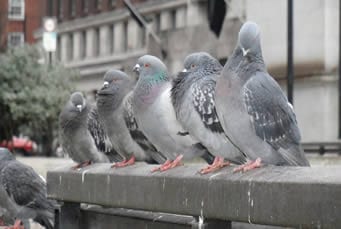
by Pigeon Patrol | Mar 21, 2022 | Bird Spike, Pigeon Patrol's Services, Pigeon Predators, Pigeon Spikes, Pigeons, Pigeons in the News
I never thought much about pigeon excrement until I moved into a condo several years ago and discovered two birds nesting on the balcony. Because my daughter was worried about the cute little eggs, I waited till the squabs were old enough to fly before clearing out the nest and piles of excrement, along with all my pigeon-defaced outdoor furniture. Then a building reno temporarily solved the problem, but as soon as the jackhammers stopped, the pigeons were back and defecating with impunity.
I decided to take action, and quickly discovered some hard facts. Pigeons, instead of nesting in trees, prefer buildings, especially tall buildings with ledges and balconies – i.e., condos. This was bad news in a city undergoing an extended real-estate boom, and this past week analysts were guessing the condo market’s record growth (about 40,000 a year for the past five years) will continue at least until 2010 – which means even more condos, i.e., more perfect pigeon abodes, i.e., more excrement.
Though there’s no pigeon census, many Toronto residents are feeling plagued by pigeons this summer. And it’s possible the rise of condos will increase the pigeon population, says Tom Mason, curator of invertebrates and birds at the Toronto Zoo.
“As the human population has increased, the pigeon population has increased with it.”
Homeowners are complaining of backyard birdfeeders being overrun with pigeons. And certain areas – like the “pigeon gauntlet” north of Broadview subway station – have become legendary. “When they’re not feasting on bread strewn by crazy old people, they’re packed onto the hydro lines above,” says a Riverdale resident. She cited a recent incident involving a man in a crisp suit, “obviously a stranger to the neighbourhood,” who walked straight under the line of fire. “It looked like someone had upended a container of yogurt on him, honestly, it was that copious. He started running around in circles, screaming, then ran off.”
So Toronto’s pigeon problem was bigger than I’d bargained for – but surely I could get them off my own balcony. I started with humane pigeon deterrents: a bobble-headed “scary” owl, fluttering strips of aluminum foil, twirly children’s toys. Nothing worked.
Whenever I heard pigeons cooing on the balcony, I hammered on the window, or leaped out the door shrieking, “Get out of here, you bastards!” In fact, I got so used to the routine that I stopped explaining the outbursts during business calls. As the battle escalated, I laid in wait with water guns, ambushing the enemy as they landed on my railing, or sneaking over to my neighbour’s balcony – where I knew pigeons were nesting behind a deck chair. There, I would jump up, crane around the partition and blast away at the cornered pigeons as they ran around in circles. One day, it occurred to me that I might encounter – and shoot – the neighbour, so I stopped.
It was time to do more research.
Know the enemy
Toronto’s feral pigeons are descended from domestic birds brought over by early settlers. Males and females look the same, are monogamous and take turns incubating eggs, which arrive two at a time. Both parents nurse the babies with a nutrient-laden “crop milk,” which can double the wee ones’ weight in 34 hours.
“What’s also amazing,” said ornithologist Mark Peck of the Royal Ontario Museum, “is that, as far as I know, they are the only bird in Ontario that breeds throughout the entire year,” which means up to nine “clutches” per annum.
Pigeons are also uniquely skilled at navigation – able to fly 70 kilometres per hour, covering up to 1,000 kilometres in a single race. In wartime, pigeons saved lives by carrying military messages across enemy lines. Science hasn’t figured out the exact mechanism, but the motivation, explains the zoo’s Mr. Mason, is that they’re frantically trying to get back to their nestlings.
This is the trouble with research. You seek data to support a pigeon-killing spree, and you end up discovering pigeons are a lot like humans, except pigeons have a lower divorce rate.
So let’s not forget their capital offences. The Nixalite Architectural Bird Control website states that pigeons are “a vector for more than 50 human and livestock diseases.” Their droppings fade finishes on cars and planes, can destroy wood, stone and marble, corrode I-beams, ruin cloth awnings, short out electrical equipment and fill attics with so much excrement “that the actual ceiling collapses.”
On an excrement-removal website, the U.S. General Services Administration warns that pigeon excrement can “lead to potentially fatal diseases of the lungs and central nervous system such as histoplasmosis and cryptococcosis.”
In fact, the Web is packed with anti-pigeon content. The problem: There seems to be no evidence of pigeon-caused plagues in real life. “That’s correct,” said Dr. David McNeely, associate professor of infectious diseases at University of Toronto. Avian-related diseases are rare to begin with, he said, and they’re usually caused by other species. “Don’t pick on poor pigeons,” Dr. McNeely said. “If you want to worry about bird-related diseases, worry about budgie dander.”
Similarly, Mr. Mason, who works at the zoo with pigeons and other birds daily, has never heard of a case. Nor has Mr. Peck at the ROM, who adds how important pigeons have been to science, from Darwin and B.F. Skinner to the present. “Pigeons are not bad birds,” Mr. Peck said. “They’re just successful.”
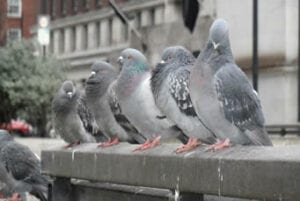
Taking action
These scientist types weren’t helping my case against pigeons at all. I phoned the city to ask if it was legal to kill them. “There are no bylaws that apply to wild pigeons,” said Rishma Govani in the public health department, though “there are rules” about owned pigeons.
Next, I spoke with Donald Fraser, principal of Beacon Environmental impact-assessment (and a former researcher on goose defecation habits, which I figured was close enough to my area of interest), who explained: “It is legal to shoot or kill pigeons because they are a non-migratory bird, and thus not covered by the migratory bird act between Canada and the United States.” You need a permit to shoot gulls, or a hunting licence to shoot geese or ducks, for example, but pigeons are fair game. Mr. Fraser did caution, however, that there might be consequences if firearms were discharged within the city.
Indeed, Constable Wendy Drummond of Toronto Police Services confirmed that, while feral pigeons were not protected by the Criminal Code (the sections on animal cruelty pertain mainly to owned animals such as cattle, she said), any discharge of a pellet gun with intent to kill would result in a weapons charge. Snapping their little necks, quickly and humanely, would be tolerated, she said, “unless, you know, we find 100 dead pigeons.”
So pigeons are good family birds, heroic during wartime and, as Mr. Fraser also pointed out, good scavengers who help keep city streets clean (when not filling them with excrement, that is, but never mind). So maybe we shouldn’t kill them. But feed and encourage them? No way.
On this point, I agreed with London Mayor Ken Livingstone, who reduced pigeon numbers in Trafalgar Square by imposing a controversial feeding ban in 2003. A friend recommended I speak to a woman who fed pigeons in her local park. Oh goody, I thought – my anti-pigeon case would definitely be enhanced by a real-live wacko, probably wearing old rags and a squashed hat covered in excrement, ranting about pigeon rights.
Well, the crazy pigeon lady turned out to be novelist Barbara Gowdy, who may or may not be as deranged as the next writer, but who is undeniably smart, attractive, well-groomed and socially responsible.
“I only feed them at the end of the park, away from homes, during inclement weather, when there is snow and ice on the ground and it’s impossible for them to get food,” Ms. Gowdy said.
For a while, when people attacked her for feeding pigeons, she handed out pamphlets from the Centers for Disease Control and Prevention, which stated, she said, that “even if you ate pigeon excrement, the only thing you’d get is a mild stomach ache.”
Ms. Gowdy is nothing if not persuasive. Or maybe I was ready to crack. After starting out on a crusade to kill all pigeons, I now considered eating pigeon excrement in order to properly research this article.
In any case, the fight had gone out of me – mainly, I think, because of one detail I couldn’t get out of my head: The reason pigeons love condos is because the high-rise towers resemble ancient cliff faces, near Asian seas, where rock doves originally made their homes. That image of our city’s condos as soaring cliffs along the edge of Lake Ontario transformed my view of both the buildings and pigeons.
Ms. Gowdy was right: Toronto’s feral rock pigeons have as much right to live here as we do, and the city would be a much poorer place without its wild animals. I’m willing to live and let live – though it would still be nice to find a way to stop them from living on my particular balcony.
Source
Pigeon Patrol Products & Services is the leading manufacturer and distributor of bird deterrent (control) products in Canada. Pigeon Patrol products have solved pest bird problems in industrial, commercial, and residential settings since 2000, by using safe and humane bird deterrents with only bird and animal friendly solutions. At Pigeon Patrol, we manufacture and offer a variety of bird deterrents, ranging from Ultra-flex Bird Spikes with UV protection, Bird Netting, 4-S Bird Gel and the best Ultrasonic and audible sound devices on the market today.
Voted Best Canadian wholesaler for Bird Deterrent products ten years in a row.
Contact us at 1- 877– 4– NO-BIRD, (604) 585-9279 or visit our website at www.pigeonpatrol.ca
Pigeon/Pigeon Patrol / Pigeons Roosting / Vancouver Pigeon Control /Bird Spikes / Bird Control / Bird Deterrent / Pigeon Deterrent? Surrey Pigeon Control / Pest /Seagull deterrent / Vancouver Pigeon Blog / Birds Inside Home / Pigeons in the cities / Ice Pigeons/ What to do about pigeons/ sparrows , Damage by Sparrows, How To Keep Raccoons Away, Why Are Raccoons Considered Pests/ De-fence / Pigeon Nesting/ Bird Droppings / Pigeon Dropping/ woodpecker control/ Professional Bird Control Company/ Keep The Birds Away/ Birds/rats/ seagull/pigeon/woodpecker/ dove/sparrow/pidgeon control/pidgeon problem/ pidgeon control/flying rats/ pigeon Problems/ bird netting/bird gel/bird spray/bird nails/ bird guard
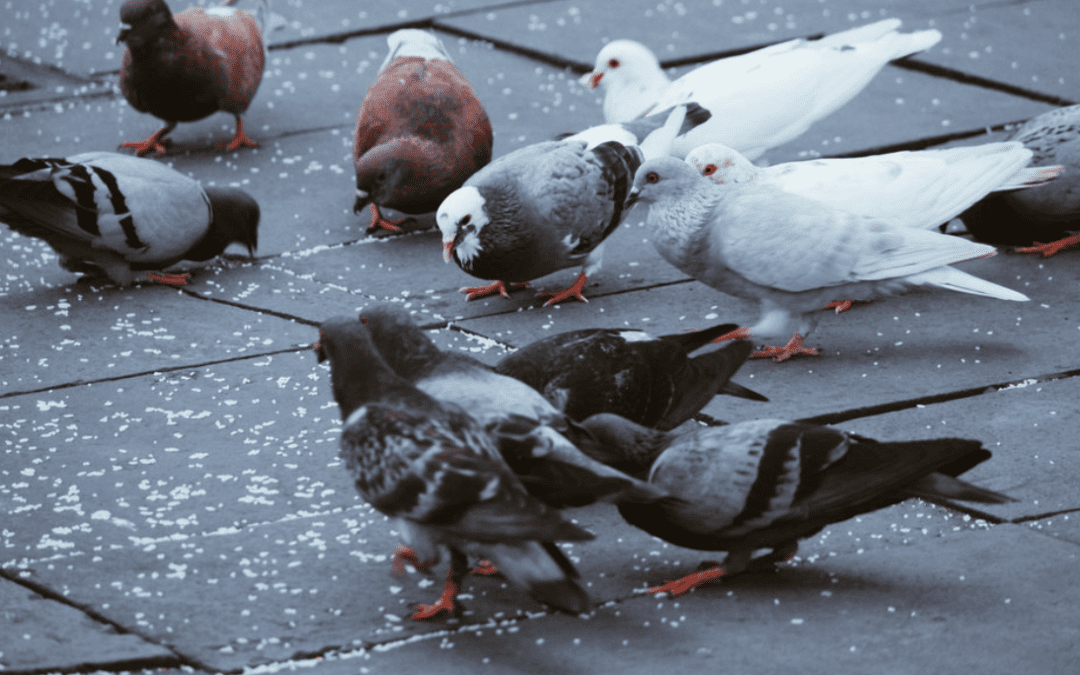
by Pigeon Patrol | Mar 7, 2022 | MBCA, pet bird, Pigeon Control, Pigeon Droppings, Pigeon Patrol's Services, Pigeon Predators
The world is urbanising rapidly, and it is predicted that by 2050, 66% of the global human population will be living in urban areas. Urbanisation is characterised by land-use changes such as increased residential housing, business development and transport infrastructure, resulting in habitat loss and fragmentation. Over the past two decades, interest has grown in how urbanisation influences fundamental aspects of avian biology such as life-history strategies, survival, breeding performance, behaviour and individual health. Here, we review current knowledge on how urbanisation influences the nesting biology of birds, which determines important fitness-associated processes such as nest predation and community assembly. We identify three major research areas: (i) nest sites of birds in urban areas, (ii) the composition of their nests, and (iii) how these aspects of their nesting biology influence their persistence (and therefore conservation efforts) in urban areas. We show that birds inhabiting urban areas nest in a wide variety of locations, some beneficial through exploitation of otherwise relatively empty avian ecological niches, but others detrimental when birds breed in ecological traps. We describe urban-associated changes in nesting materials such as plastic and cigarette butts, and discuss several functional hypotheses that propose the adaptive value and potential costs of this new nesting strategy. Urban areas provide a relatively new habitat in which to conserve birds, and we show that nestboxes and other artificial nest sites can be used successfully to conserve some, but not all, bird species. Finally, we identify those subject areas that warrant further research attention in the hope of advancing our understanding of the nesting biology of birds in urban areas.
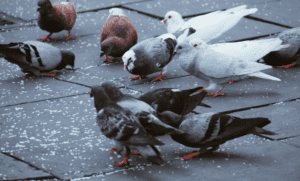
Source
Pigeon Patrol Products & Services is the leading manufacturer and distributor of bird deterrent (control) products in Canada. Pigeon Patrol products have solved pest bird problems in industrial, commercial, and residential settings since 2000, by using safe and humane bird deterrents with only bird and animal friendly solutions. At Pigeon Patrol, we manufacture and offer a variety of bird deterrents, ranging from Ultra-flex Bird Spikes with UV protection, Bird Netting, 4-S Bird Gel and the best Ultrasonic and audible sound devices on the market today.
Voted Best Canadian wholesaler for Bird Deterrent products ten years in a row.
Contact us at 1- 877– 4– NO-BIRD, (604) 585-9279 or visit our website at www.pigeonpatrol.ca
Pigeon/Pigeon Patrol / Pigeons Roosting / Vancouver Pigeon Control /Bird Spikes / Bird Control / Bird Deterrent / Pigeon Deterrent? Surrey Pigeon Control / Pest /Seagull deterrent / Vancouver Pigeon Blog / Birds Inside Home / Pigeons in the cities / Ice Pigeons/ What to do about pigeons/ sparrows , Damage by Sparrows, How To Keep Raccoons Away, Why Are Raccoons Considered Pests/ De-fence / Pigeon Nesting/ Bird Droppings / Pigeon Dropping/ woodpecker control/ Professional Bird Control Company/ Keep The Birds Away/ Birds/rats/ seagull/pigeon/woodpecker/ dove/sparrow/pidgeon control/pidgeon problem/ pidgeon control/flying rats/ pigeon Problems/ bird netting/bird gel/bird spray/bird nails/ bird guard
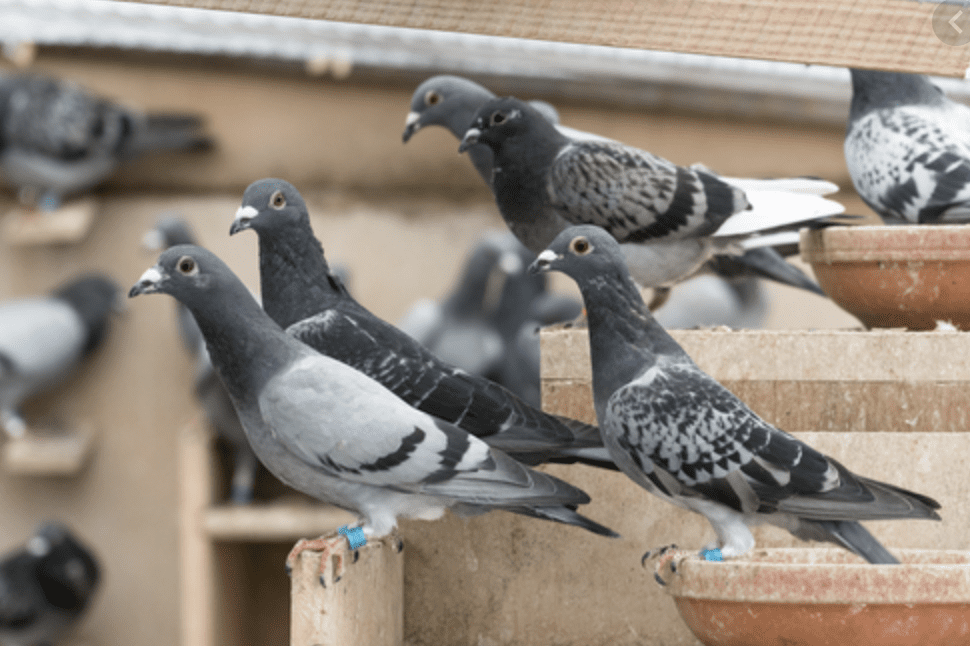
by Pigeon Patrol | Mar 7, 2022 | history of pigeons, MBCA, pet bird, Pigeon Control, Pigeon Droppings, Pigeon Patrol's Services, Pigeon Predators
Impatient for winter to be over, we had put on our boots to go seeking signs of spring but had instead found a sign of the previous summer. We must have walked past this thicket a score of times last summer without ever noticing birds around it, but here is a bird’s nest among the branches, at eye level, in plain sight now that winter has stripped away the last of the leaves.
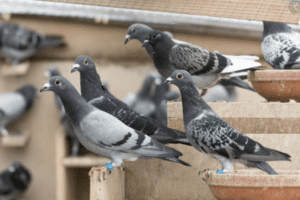
It would be easy enough to pass it by. If we pause to look closely, though, it becomes more intriguing. We may never know what kind of bird built the nest, because there are several species here that might construct this type: an open-cup shape lashed into a three-way fork in an upright twig. But it inspires a sense of wonder beyond mere questions about identification. Somehow a small bird knew how to gather the myriad materials for this structure. Somehow this bird arranged scores of small pieces of twig and grass and weed and bark, weaving them together with such precision that the nest is still sturdy and secure after being exposed to the winter’s rain and wind. Considered in the proper light, this little bundle of dried vegetation is really a small miracle.
“My favorite palette is the color of winter decay,” says photographic artist Sharon Beals. It’s 7 a.m. in San Francisco, but she is already on her way out the door to work on her project for the day. Much of her professional photography takes her outside, “wandering a river for hours, looking at bugs, muck, and minnows,” as she says, or photographing native plants or their pollinators. Today, though, she will spend up to 11 hours in a museum, examining birds’ nests and photographing many of them. The results will add to her growing collection of nest portraits—extraordinarily detailed images that have already wowed scientists and artists alike.
Beals became immersed in this subject almost by chance when a friend, knowing her fascination with the subtle minutiae of nature, brought her an abandoned bird nest. Studying it, she knew she had to find a way to capture its intricacy. Using a very high-resolution flatbed scanner, she made images of this nest, and then another, and another.
But problems loomed. For one thing, she says, after turning a nest upside down on the scanner, she might have to spend hours cleaning all the dust that falls from the nests off the images in Photoshop. For another, as she discovered, possessing these nests was illegal.
Beals overcame the first challenge by moving to very high-resolution cameras and by taking multiple exposures, focusing on different planes, then melding the images together. But the second problem was tougher. The laws protecting U.S. birds are far more sweeping than most people imagine. Without special permits, it is illegal for private citizens to possess most species of native birds, or their feathers, or their eggs, or even their abandoned nests. The laws may seem excessive, but they were enacted at a time when our birds were under siege from commercial plume hunters and recreational egg collectors, and they were written to be wide-ranging and inclusive. Rather than give up or break the law, Beals turned to the Museum of Vertebrate Zoology and the California Academy of Sciences, and soon had permission to come in and photograph nests from among the hundreds in the institutions’ specimen collections.
The popular image of natural history museums may be of a handful of stuffed creatures on public display in glass cases, but most keep the majority of their specimens in research collections out of public view. The nests at the California Academy of Sciences were mostly collected decades ago, at a time when relatively little was known about birds’ habits. These specimens provided basic data points then, and they continue to be scientifically valuable today.
For Sharon Beals, they also provided a treasure trove of artistic possibilities. She spent days at the academy, examining and photographing nests. “These first images gave me the satisfaction of seeing the materials on almost a cellular level,” she says. “I loved the quiet, subdued palette, and the shapes created by the form-follows-function art of the nest builders themselves. I loved the amazing variety of content and construction, the way the materials became like line and brushstroke.” When she began printing the images larger than life, on sheets of fine etching paper two feet across, others shared her enthusiasm. Visitors to her studio were fascinated. Almost invariably they became intensely curious. Beals had found a way to make people see the nests, truly see them, as cause for wonder and for endless questions about the birds that built them.
Birds do not live in their nests the way humans live in their houses. A few species, such as some wrens, will use them as shelters to sleep in at night, but they are the exceptions. For the majority, the nest is just a cradle. Built to hold the eggs and the helpless young, it is abandoned once the young birds are old enough to leave. In most cases it is never used again.
There is evidence that some dinosaurs built primitive nests on the ground and even cared for their hatchlings there. Today many creatures besides birds—from wasps to mice to alligators—shelter their young or their eggs in nests that they construct themselves. But for variety of placement and material, and for sheer complexity of design, nothing can compare with birds’ nests. Especially among smaller birds, nests are often remarkable for their inventive use of local materials to provide support, shelter, and camouflage. The nests are tiny marvels of disposable architecture.
The skill to create them comes almost entirely from instinct (although there is evidence that young adult birds, making their first nests, do improve with practice). Studies have shown that at least some birds, hand-raised in captivity, can build a nest typical of their own species without ever having seen one. The instinct to do this must be flexible, because the locations and materials available for nests in the wild vary, but it must be based on a considerable amount of precision as well.
Even a small bird’s relatively simple nest may be composed of several kinds of material used for different purposes. For example, a white-crowned sparrow’s may have coarse twigs at the base, finer twigs and weeds intertwined with rootlets and bark strips to form the open cup, dry leaves in the outer edge, and fine grasses and other soft materials molded into an inner lining. And that’s just a simple number. A more complex nest, such as the long hanging pouch of an American oriole, may involve actual weaving or sophisticated knots tied in long plant fibers, and it may take days of intense effort to build.
Most birds are opportunistic when it comes to building materials, and will readily incorporate manmade items into their nests if they fit basic requirements of size and texture. Paper, string, nails, pieces of wire, and bits of fabric regularly show up in the handiwork of suburban birds. In some areas house finches have become a minor nuisance by dismantling nylon window screens to use the strands for their nests.
In many cases, though, the materials chosen must have specific properties. Studies of nesting European starlings have found that the birds were selecting certain plants, such as wild carrot and yarrow, containing chemicals that would inhibit the growth of mites and other parasites. In eastern North America the great crested flycatcher often adds a piece of shed snakeskin, and the power of suggestion imparted may help deter predators or other intruders. Chipping sparrows often use animal hair (gathered in farmyards, or even plucked from startled pets) for their nest lining. Feathers are also ideal for soft, insulating lining material. Big birds like quail or ducks use their own down feathers for this purpose, but swallows and other small birds prefer feathers dropped by larger birds. A truly extreme example of material gathering is practiced by certain tropical swifts, fast-flying small birds that will actually strike much larger birds in midair to knock feathers loose.
As a very general rule, females are the skilled builders. For many species they do all the construction, including some (such as hummingbirds) for which males abdicate any responsibility for helping with the nest or young. In other cases, the male provides the basic foundation and the female adds the detailed lining. A male marsh wren may build 20 or more “dummy nests” around his territory; the female chooses one, adds lining, and uses it as the actual site for the eggs. The male’s building spree is not wasted effort: The presence of all those decoys may provide some protection for the real one, as predators tire of raiding nests that turn out to be empty.
Some of the most impressive nests are also among the smallest. A hummingbird nest is a wondrous creation of tiny plant fibers, mosses, and spiderwebs, so small that a 50-cent piece would completely cover it. It is as soft as felt but strong, with the spiderwebs making it pliable enough to stretch and expand as the rambunctious young hummers grow and exercise in it. Many hummingbirds will camouflage the outside with bits of lichen. At a distance such an object looks, for all the world, like a natural bump or knob on the branch, thereby deceiving potential predators in the mother bird’s absence.
At the opposite extreme are eagles. A pair of bald eagles may use the same nest for years, adding material to it annually until it becomes huge (an extreme example can reach a depth of 20 feet and a weight exceeding two tons). Such a nest is merely a ramshackle heap of sticks, hardly an admirable piece of avian architecture, but it does have its admirers: House sparrows and other small birds sometimes tuck their own nests into the lower crevices, and great horned owls may commandeer the entire nest, perhaps even driving the eagles from their aerie.
The finest nests are crafted by smaller birds, however, and the majority are never reused, not even by their original builders. It seems all the more remarkable that birds should create these intricate structures for such ephemeral use. It seems ironic, too, that most of us are not legally allowed to possess these nests, even after they have been abandoned. But when we are lucky enough to find them in the wild, or see them revealed in works of photographic art like the ones reproduced here, we cannot avoid holding them and the birds that made them in absolute awe.
Source
Pigeon Patrol Products & Services is the leading manufacturer and distributor of bird deterrent (control) products in Canada. Pigeon Patrol products have solved pest bird problems in industrial, commercial, and residential settings since 2000, by using safe and humane bird deterrents with only bird and animal friendly solutions. At Pigeon Patrol, we manufacture and offer a variety of bird deterrents, ranging from Ultra-flex Bird Spikes with UV protection, Bird Netting, 4-S Bird Gel and the best Ultrasonic and audible sound devices on the market today.
Voted Best Canadian wholesaler for Bird Deterrent products ten years in a row.
Contact us at 1- 877– 4– NO-BIRD, (604) 585-9279 or visit our website at www.pigeonpatrol.ca
Pigeon/Pigeon Patrol / Pigeons Roosting / Vancouver Pigeon Control /Bird Spikes / Bird Control / Bird Deterrent / Pigeon Deterrent? Surrey Pigeon Control / Pest /Seagull deterrent / Vancouver Pigeon Blog / Birds Inside Home / Pigeons in the cities / Ice Pigeons/ What to do about pigeons/ sparrows , Damage by Sparrows, How To Keep Raccoons Away, Why Are Raccoons Considered Pests/ De-fence / Pigeon Nesting/ Bird Droppings / Pigeon Dropping/ woodpecker control/ Professional Bird Control Company/ Keep The Birds Away/ Birds/rats/ seagull/pigeon/woodpecker/ dove/sparrow/pidgeon control/pidgeon problem/ pidgeon control/flying rats/ pigeon Problems/ bird netting/bird gel/bird spray/bird nails/ bird guard

by Pigeon Patrol | Mar 7, 2022 | MBCA, pet bird, Pigeon Control, Pigeon Droppings, Pigeon Patrol's Services, Pigeon Predators
This morning as I was getting some worked finished, I noticed two crows on the roof across our ally. They had a large object which I first thought was something from the dumpster and then noticed what looked like it had chicken feet. I opened the window to get photos. Because it was cold out, the heat from my window made for some fierce shimmer and the photos are blurry…but you get the idea of what they are eating. Again, if you don’t like gross stuff, or don’t like the whole predator prey relationship thing, stop reading now.

 When I first saw the feet, I was reminded of the quail that we get to feed the birds at The Raptor Center, but there are no quail around here. Then I realized that the bird the crows were eating had only pin feathers–it was a young bird from a nest. By the size, I realized that they were eating a pigeon nesting.
When I first saw the feet, I was reminded of the quail that we get to feed the birds at The Raptor Center, but there are no quail around here. Then I realized that the bird the crows were eating had only pin feathers–it was a young bird from a nest. By the size, I realized that they were eating a pigeon nesting.
 The two crows made short order of the chick. By the size and development, I would guess that the pigeon was about ten days old–which is interesting in and of itself. If the pigeon chick was about ten days old, the egg would have been laid 18 days before that, so the pigeon parents were busy in early March–at least two snow storms ago.
The two crows made short order of the chick. By the size and development, I would guess that the pigeon was about ten days old–which is interesting in and of itself. If the pigeon chick was about ten days old, the egg would have been laid 18 days before that, so the pigeon parents were busy in early March–at least two snow storms ago.
The pigeon nest was tucked in a nook on the roof of an apartment building just to the right of where the crows were eating. I’ve seen pigeons in and out of there all winter and assumed roosting–I didn’t guess that they were on eggs last month.
 When the crows were finished, I went back to business in my apartment. About fifteen minutes later I found them working on another chick. That surprised me. It makes sense to clean out a whole robin nest–those are small chicks, but a pigeon chick is fairly large, I was surprised that they ate both nestlings right away, but when you find a huge protein source like that and you are in the process of laying eggs yourself, you’re not gonna be able to resist it.
When the crows were finished, I went back to business in my apartment. About fifteen minutes later I found them working on another chick. That surprised me. It makes sense to clean out a whole robin nest–those are small chicks, but a pigeon chick is fairly large, I was surprised that they ate both nestlings right away, but when you find a huge protein source like that and you are in the process of laying eggs yourself, you’re not gonna be able to resist it.
 And let’s keep in mind that this is gross and it may not be pretty to watch a crow clean out a nest–but they are not the only ones to do it. Blue jays do it, hawks do it, owls do it–even woodpeckers do it. Heck, even nut job humans in England do it. Crows are just more obvious about it.
And let’s keep in mind that this is gross and it may not be pretty to watch a crow clean out a nest–but they are not the only ones to do it. Blue jays do it, hawks do it, owls do it–even woodpeckers do it. Heck, even nut job humans in England do it. Crows are just more obvious about it.
Source
Pigeon Patrol Products & Services is the leading manufacturer and distributor of bird deterrent (control) products in Canada. Pigeon Patrol products have solved pest bird problems in industrial, commercial, and residential settings since 2000, by using safe and humane bird deterrents with only bird and animal friendly solutions. At Pigeon Patrol, we manufacture and offer a variety of bird deterrents, ranging from Ultra-flex Bird Spikes with UV protection, Bird Netting, 4-S Bird Gel and the best Ultrasonic and audible sound devices on the market today.
Voted Best Canadian wholesaler for Bird Deterrent products ten years in a row.
Contact us at 1- 877– 4– NO-BIRD, (604) 585-9279 or visit our website at www.pigeonpatrol.ca
Pigeon/Pigeon Patrol / Pigeons Roosting / Vancouver Pigeon Control /Bird Spikes / Bird Control / Bird Deterrent / Pigeon Deterrent? Surrey Pigeon Control / Pest /Seagull deterrent / Vancouver Pigeon Blog / Birds Inside Home / Pigeons in the cities / Ice Pigeons/ What to do about pigeons/ sparrows , Damage by Sparrows, How To Keep Raccoons Away, Why Are Raccoons Considered Pests/ De-fence / Pigeon Nesting/ Bird Droppings / Pigeon Dropping/ woodpecker control/ Professional Bird Control Company/ Keep The Birds Away/ Birds/rats/ seagull/pigeon/woodpecker/ dove/sparrow/pidgeon control/pidgeon problem/ pidgeon control/flying rats/ pigeon Problems/ bird netting/bird gel/bird spray/bird nails/ bird guard









